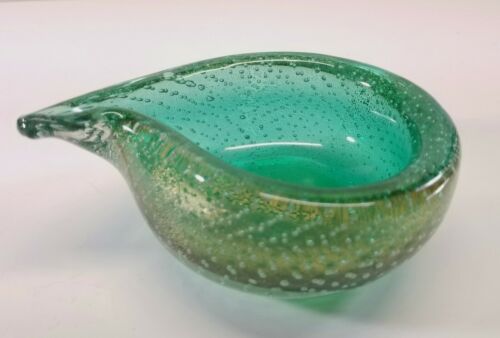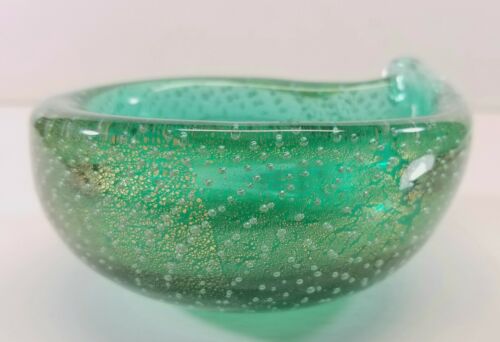-40%
Vintage Italian Murano Ashtray Green w Gold Iridescent Sheen Bubbled Glass VFINE
$ 15.83
- Description
- Size Guide
Description
Vintage - Italian MuranoAshtray -
Green with Gold Iridescent Sheen Bubbled Glass - Very FINE
Authentic vintage Murano hand-blown art glass ashtray, made in Italy (see notes on Murano history, below). Thick glass with layers of color that vary from watery aqua to metallic gold behind an outer layer embedded with tiny bubbles. Paisley or raindrop shape with flat bottom.
Please also see our
Condition Description
, and photographs.
Measures 5" from pointed side to opposite side x 3 7/8" and 1 7/8" tall/deep.
Lot weight is
1 lb. 1 oz., estimated shipping weight is 1-2 lbs. Will be thoroughly padded and carefully packed for secure, intact arrival.
U.S. Shipments:
Will be insured and shipped USPS Priority Mail.
Adapted from Wikipedia
– Venetian glass (Italian: vetro veneziano) is thought to have been made for more than 1,500 years with production concentrated on the Venetian island of Murano since the 13th century. Today Murano is known for its art glass, but it has a long history of innovations in glassmaking and was Europe's major glassmaking center from the Middle Ages through the Renaissance. During the 15th century, Murano glassmakers created cristallo—which was almost transparent and considered the finest glass in the world. Murano glassmakers also developed a white-colored glass (milk glass called lattimo) that looked like porcelain. Later, Europe's finest mirrors were made on Murano.
Venice was controlled by the Byzantine Empire but became an independent city state and flourished as a trading center and seaport. Its connections with the Middle East helped its glassmakers expand their skills, as glassmaking was more advanced in areas such as Syria and Egypt. Venetian glassmaking factories existed as far back as the 8th century but beginning in 1291 a legal mandate moved glassmaking to Murano. Since glass factories often caught fire, this change reduced the possibility of a catastrophic fire in the city of Venice. Also, Venetian glass artisans developed secret recipes and methods for glass making and moving all glassmaking to the island, artisans were better able to protect their secrets.
As Europe's elite glassmaking center, Murano peaked in popularity in the 15th-16th centuries. Venice dominated trade along the Mediterranean Sea, establishing a wealthy merchant class known as connoisseurs of the arts, helping to build demand for Murano art glass and other artistic innovations.
Eventually, glassmaking talent and production grew in Europe and the importance of Venice and its Murano glassmakers diminished. In 1797, the occupation and dissolution of the Venetian state by Napoleon Bonaparte caused more hardship for Murano's glassmaking industry.
Murano began a glassmaking revival in the 1920s. Today, Murano and Venice are tourist attractions, and Murano is home to numerous glass factories and a number of artists' studios. Its Museo del Vetro (Glass Museum) in the Palazzo Giustinian maintains displays that document the history of glassmaking as well as glass samples from Egyptian times to the present day.
















